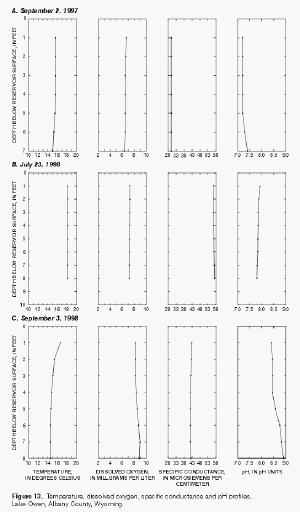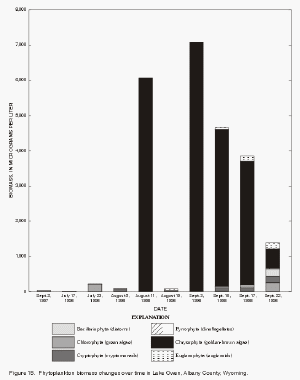
Lake Owen
Lake Owen is the shallowest and smallest in the series of reservoirs (fig.
2B; table 1). Its maximum depth is about 10 ft and it contains only about 1 percent of the storage capacity of the system. Although lower in elevation than Rob Roy Reservoir, Lake Owen is located in a high mountainous area and has a spillway elevation of 8,955 ft above sea level. The vegetation surrounding Lake Owen is composed of mixed evergreen and aspen areas with some open meadow. Lake Owen is used primarily for recreational activities such as boating and fishing.
|
Probably due to its shallow depth, Lake Owen is not stratified. The September 2, 1997 profiles of Lake Owen
(fig. 13) did not indicate stratification. The water temperature was about 15°C, the dissolved oxygen was about 6.5 mg/L, the specific conductance was about 30 µS/cm, and the pH was about 7.2. The Secchi disk was still visible when resting on the reservoir bottom. Profile data collected September 16, 1997 indicate a sharp drop in water temperature. The water temperature was just over 11°C on September 16
(Appendix A).
Lake Owen also was not stratified in 1998. The July 23, 1998 profile showed a consistent water temperature of 18.2°C, dissolved oxygen decreased from 7.3 to 7.2 mg/L, the specific conductance was about 57 µS/cm, and pH decreased from 7.9 to 7.8. By September 3, 1998 the temperature decreased from 16.6 to 14.6°C, dissolved oxygen increased from 8.2 to 9.0 mg/L, specific conductance remained around 42 to 43 µS/cm, and pH increased from 8.4 to 8.9.
The temperature changes probably were facilitated by Lake Owen's high elevation, shallow depth, large surface-area exposure, and the seasonal climatic change. Temporal changes indicate that although Lake Owen warms by mid-July, it cools quickly in the fall
(fig. 14). Water transparency, as measured by a Secchi disk, ranged from a minimum of 4.6 ft on August 10, 1998 to 7.3 ft on July 17, 1998
(fig. 4). |

Figure 13. Temperature, dissolved oxygen, specific
conductance, and pH profiles.
(Click on image for a larger version, 35kb) |

Figure 14. Temporal variation of temperature with depth in Lake Owen,
Albany County, Wyoming, in summer and fall, 1998.
|
The golden-brown algae (chrysophyta) dominated the phytoplankton community in Lake Owen. The biomass of the golden-brown algae ranged from about 3,500 to 7,1000 µg/L in samples collected on August 11 and during early to mid-September 1998 (fig.15). The cause for the low concentration of phytoplankton on August 19, between 2 weeks of higher concentrations, is unknown. Green algae were present in nearly all of the samples, whereas the dinoflagellates and euglenoids appeared only in the late summer samples (fig.15).
Uroglenopsis
was the dominant species of
chrysophyte in the samples from Lake Owen. The maximum biomass of
Uroglenopsis
was 7,000 µg/L (30,500 cells/mL) in the September 3, 1998 sample (Appendix B, table
B2). Other
chrysophytes, such as
Dinobryon
and
Mallomonas,
were present in smaller quantities in some samples. Green algae were the most diverse group of algae in Lake Owen; of the 37 taxa identified, 14 taxa were green algae.
Cosmarium
was the most common green algae, particularly in the samples collected on July 23 and September 22 (fig. 15). The green algae
Quadrigula
and Tetraspora
were present at biomasses less than 100 µg/L. Other species of algae identified include the diatoms,
Asterionella
and
Fragilaria, the euglenoids
Euglena
and
Trachelomonas, and the dinoflagellate
Gymnodinium.
|

Figure 15. Phytoplankton biomass changes over time in Lake
Owen, Albany County, Wyoming.
(Click on image for a larger version, 16kb) |
Lake Owen is the only reservoir in this study to have extensive macrophyte growth. This may be due in part to the shallow depth of Lake Owen, which allows sunlight to penetrate to the bottom and in turn, allows photosynthesis by rooted plants. On some occasions, the Secchi disk was still visible as it rested on the lake bottom.
Protozoa were present in some samples, mostly at small concentrations. The exception was the September 17 sample, which contained a biomass of 13,000 µg/L of ciliated
protozoans. Biomasses of other protozoans in the samples typically were less than
50 µg/L.
In Lake Owen in the fall of 1997, MPA was dominated by non-diatomaceous phytoplankton and diatoms. A few rotifers were detected. This rotifers group are
suspension feeders that influence algae species through selective feeding. The MPA results are summarized in
table 5.
Due to the shallow depth of Lake Owen and lack of variability in the profile data, only a single surface sample was collected for water quality. Dissolved-solids
concentration was 20 mg/L (fig. 7). The water was a calcium bicarbonate type. The relative concentrations of major ions are shown on the pie diagram
(fig. 8). Dissolved-fluoride concentration was less than the detection level of 0.1 mg/L. Silica concentration, as dissolved SiO2, was 2.5 mg/L
(fig. 9). Nutrient concentrations were less than the detection limit.
Trace-element concentrations in samples were variable (table
2). Dissolved-iron concentration at 130 µg/L was the highest in any sample collected from the four reservoirs
(fig. 10). A possible source for this iron might be a magnetite gabboro (Lake Owen mafic complex, Precambrian) which outcrops at the reservoir. Houston and Orback (1976) found that unit to contain more than 10 percent magnetite in the gabbro and sparse layers of massive magnetite several inches thick. Dissolved-manganese concentration was slightly higher than surface samples collected from the other reservoirs.
On July 23, 1998, bottom sediment samples were collected at five sites (fig.
2B) in Lake Owen and composited into a single sample. The composite sample was analyzed for selected constituents
(table 3). The nitrogen concentration, reported as total nitrite plus nitrate, was 8 mg/kg. Of the constituents analyzed, aluminum was present at the highest concentration at 6.9 percent, iron was 2.7 percent, and calcium was 2.2 percent. Trace-element concentrations of arsenic, bismuth, cadmium, europium, gold, holmium, molybdenum, silver, tantalum, tin, and uranium were less than the detection limit. When thorium, vanadium, cerium and chromium concentrations are plotted
(fig.12), it is apparent that the sediment concentrations are more like the crustal average than either diabase or granitic rocks. The trace-element concentrations are probably similar to crustal averages due to the local geology, which is composed of sedimentary deposits
(Tertiary age) and metasedimentary and metavolcanic rocks (Pre-Cambrian age). Near Lake Owen, alluvium, gravel,
colluvium, conglomerate sandstones, and shales occur, along with medium to coarse grained gabbros, and other mafic rocks.
[Table of Contents] [Abstract]
[Introduction]
[Rob Roy Reservoir]
[Lake Owen]
[Granite Springs
Reservoir] [Crystal Lake Reservoir]
[Summary]
[Appendix A]
[Appendix B]


